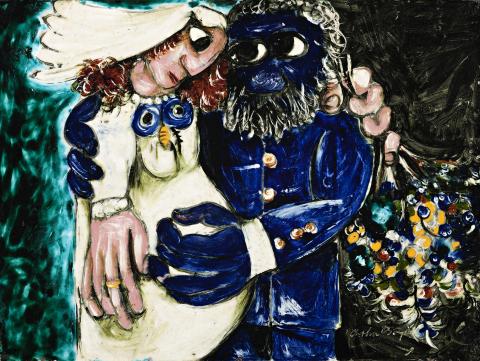PROTECTION, 1957 – 58
ARTHUR BOYD
glazed ceramic tile
45.5 x 61.0 cm
signed lower right: Arthur Boyd
Guelda Pyke, Melbourne
Thence by descent
Private collection, Melbourne
Exhibition by Arthur Boyd: Allegorical Paintings, Australian Galleries, Melbourne, 22 April – 5 May 1958, cat. 8
Arthur Boyd Exhibition, David Jones Art Gallery, Sydney, 1 – 13 October 1958, cat. 8
Arthur Boyd: the Bride, Heide Park and Art Gallery, Melbourne, 8 November – 14 December 1986, cat. 6
Philipp, F., Arthur Boyd, Thames and Hudson, London, 1967, pp. 146 (fn. 24), 252 (6.86)
Smith, G., ‘Catalogue raisonne’, in: Morgan, K. et. al., Arthur Boyd: Brides, Heide Museum of Modern Art, Melbourne, 2014, cat. 37, p. 67
In 1958, Arthur Boyd stunned local audiences with a major cycle of paintings depicting the doomed loved triangle of an Aboriginal man, his half-caste wife and the groom’s imagined ideal of a white, European bride. Colloquially known as the ‘Bride’ series,1 these works were originally shown under the title of ‘Allegorical Paintings’ and catalogue marginalia from the time describes them as being ‘(t)remendously strong, disquieting and anguished. Impossible to live with but above all superbly painted and controlled in composition.’2 One reason for their impact was their sheer physical scale as the sixteen paintings were each amongst the largest exhibited to date by a post-War Australian artist. However, within this overwhelming display were some smaller scale works, the most intimate of which was the ceramic tile on offer here, the poetically suggestive Protection.3
The ‘Bride’ series had its genesis in a journey undertaken by the artist to Central Australia in 1953.4 As a white middle-class boy from Melbourne, Boyd was entirely ignorant of the true plight of the Australian aborigine and what he found there astounded and deeply troubled him. Key to the resulting paintings was an incident he witnessed where a group of aboriginal women, dressed in wedding dresses, were carted to a ceremony on the back of a flat top truck. On return to Melbourne, his confusion and insufficient understanding led him to harshly describe the aboriginal population as being as ‘really pathetic. Lounging about on street corners at a loose end. No fight like the Negroes...’5 As with his peers, Boyd had at that stage experienced a greater interaction with wartime American GIs than with the original inhabitants of his homeland. However this was to change as Boyd, a genuine humanist, contemplated what he had witnessed.
Known primarily as a painter, Boyd had established a pottery in Murrumbeena in 1944 with the artist John Perceval and the philosopher Peter Hebst (Boyd’s father Merric is regarded as the founder of studio ceramics in Australia). Branded as the AMB (Arthur Merric Boyd) Pottery, the main production was of hand-decorated domestic ware, but Boyd also produced more than 100 ceramic tiles between 1949 and 1953. Most featured biblical subjects and the imagery was applied in thin painterly layers of glaze with the result echoing the translucent depth of stained glass. For the artist, this process had more importance than simple experimentation. ‘It was the most marvellous feeling … a painting doesn’t have anywhere near the impact of pulling something out that has been almost purged by being through fire…. It is a pure object and it is changed. It’s formed in the fire and so the surprise is marvelous.’6 In 1956, the landmark Australian Galleries was established in Melbourne and shortly after, Boyd was taken on and paid a monthly stipend by the directors, Tam and Anne Purves. Financially stable for once, Boyd now found time to concentrate on the conflicted ideas that had been bubbling in his mind since the Central Australian experience.
In his home-studio at Surf Avenue, Beaumaris, the artist set to work envisaging a saga of the doomed lovers ‘trapped in the space between two cultures, estranged and dreaming in a world of fantasy into which (they were) equally locked. The theme is frustration.’7 In most of the images, the Aboriginal groom appears to spurn his wife as he aspires to his dream bride but this single tile provides a tender contrast. Here, he ‘places his huge hand protectively on the pregnant bride – the only affectionate gesture in the series.’8 Amidst the turbulence and high drama of the exhibition’s monumental paintings, the discrete scale of Protection would have provided a delicate counterpoint reinforcing the beauty of its familial message. Purchased at the time by his colleague, the Bell School artist Guelda Pyke, it has remained within her family and is now offered publicly for the first time since its original exhibition nearly sixty years ago.
1. Also referred to as ‘Love, Marriage and Death of a Half-Caste’
2. Unidentified author. Notes inscribed on original exhibition catalogue, Arthur Boyd (Australian Art and Artist file), State Library of Victoria, Melbourne
3. The exhibition comprised 16 paintings, 3 studies, 1 sketch, and 1 tile.
4. Not 1951 as is commonly listed. The journey occurred during October/November 1953. See: Morgan, K, ‘Boyd’s Brides: a modern allegory’, in: Morgan, K. and others, Arthur Boyd: Brides, Heide Museum of Modern Art, Melbourne, 2014, p. 11 fn. 5.
5. Arthur Boyd to Tim Burstall, 14.11.1953, quoted in: McPhee, H., Memoirs of a Young Bastard: the diaries of Tim Burstall, Miegunyah Press, Melbourne, 2012, p. 5
6. Arthur Boyd, quoted in: Pearce, B., Arthur Boyd: retrospective, Beagle Press, Sydney, 1993, p. 169
7. Ludeman, B., ‘Introduction’, Arthur Boyd: the Bride, Heide Park and Art Gallery, Melbourne, 1986, non-paginated
8. Philipp, F., Arthur Boyd, Thames and Hudson, London, 1967, p. 146, fn. 24
ANDREW GAYNOR
